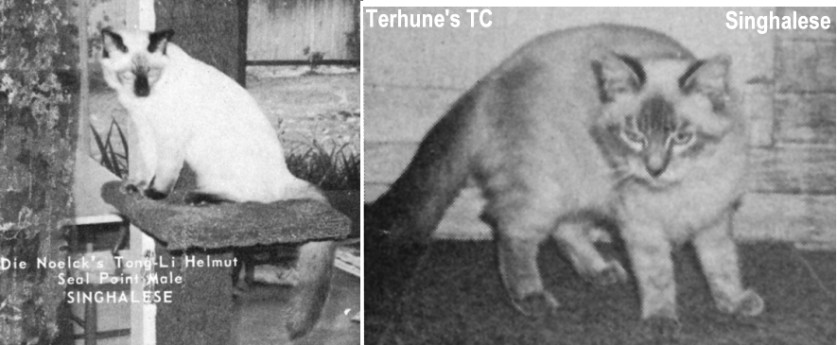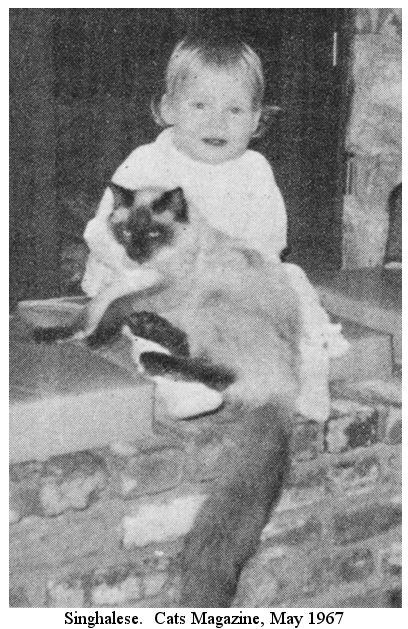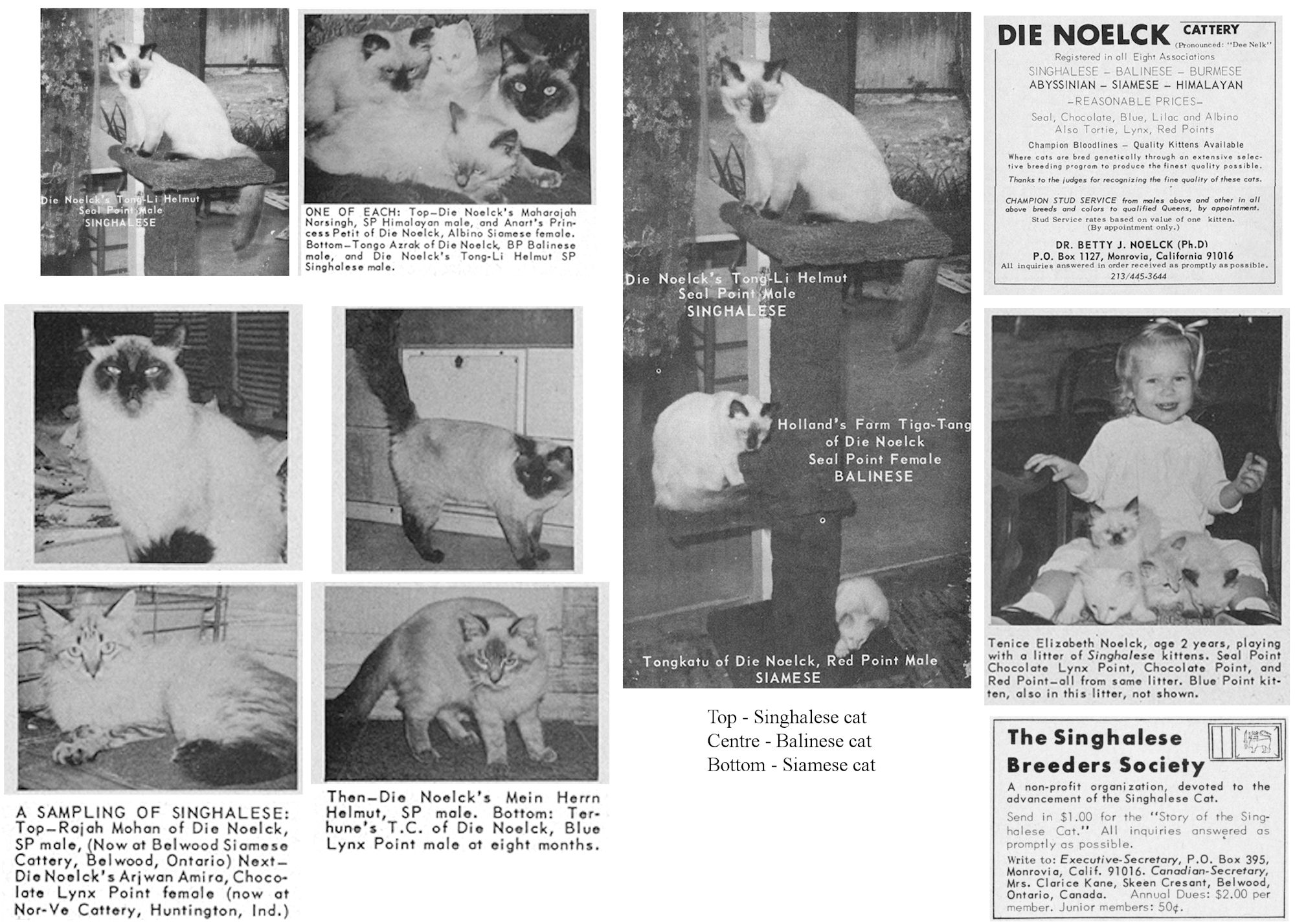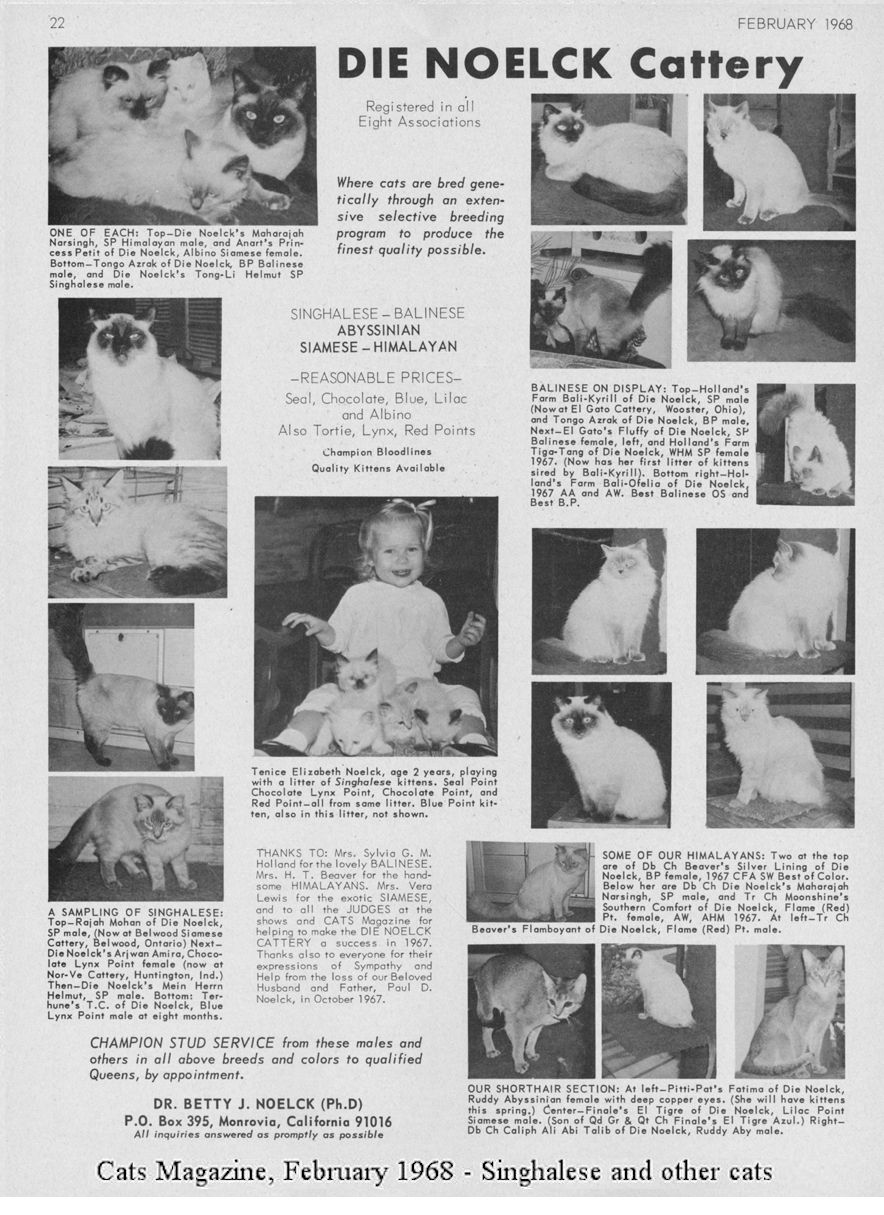
LOST BREEDS – SINGHALESE
The Singhalese was a long-haired Siamese-type cat developed in the USA and Canada in the late 1960s using Siamese cats crossed with red/red-tabby Angoras. The aim was to create a semi-longhaired Siamese-type cat. Its fur was shorter and fluffier than the Balinese and its tail was much fluffier. These were red-series equivalents of Balinese and were bred in red-point and tortie-point. US registries only recognised the similar Balinese in seal, blue, lilac and chocolate points. Its temperament was calmer and closer to the Angora than to the more highly strung Siamese. It ultimately lost out to the Balinese which was being bred in its own right since the early 1960s. While the Balinese arose from long-haired “sports” appearing in Siamese litters, the Singhalese was bred from Siamese cats crossed to the “Angora-Persian” – Persian cats that resembled the Angora (and that now masquerade as ‘Turkish Angora’ in the USA). It was too close in appearance to the Balinese, and its originator’s rationale was perhaps too muddled, for it to be a viable breed. The Singhalese was allowed to be bred to either Balinese or to Himalayan and the progeny could be registered as Singhalese, however it was judged to the Balinese breed standard with allowances made for its shorter, fluffier coat and fuller tail, rather than having its own standard. It seems to have been too close in type to the Balinese to be a viable proposition; especially when flame-point Balinese appeared.

An article “Singhalese – The Newest Longhairs” by Dr Betty L. Noelck was published in Cats Magazine Feb 1967. Apart from advertising, that article and the responses to the article, the Singhalese has left no paw-prints on cat breed history.
Noelck described the Singhalese cat as a new recognised breed named after careful consultation and “with the benefit of the cat fancy in mind,” by a large group of geneticists and breeders that had formed together as “The Singhalese Breeders Society.” The Singhalese Breeders Society became affiliated with the ACA and there were apparently well over thirty breeders in North America including Dr. Jesse Greenstein (California), Mrs. Clarice Kane (a Siamese breeder) and Dr. Betty J. Noelck herself (California). Noelck’s article contained a number of fundamental genetics errors which did not help to further her cause.
She wrote “The Singhalese cat conforms to the Siamese body and colour standard except that it is long-haired, similar to the Balinese. At present these cats have a medium length body coat, not as long as the Balinese, and with a very soft silky texture, without the thick undercoat like the Himalayan. Their tail is very long-haired and fluffy […] their beautiful tail is their most outstanding asset. They have a very sweet, affectionate disposition and do not object to rough handling during play when rough housing with them. They are very intelligent and are very easy to train. The Singhalese cat is very viable and virile, not as easily susceptible to pneumonitis and other viruses as other Siamese type breeds.”
“Several breeders have accidentally come up with long-haired Siamese from time to time, which they are then forced to call ‘Himalayan,’ even though they do not meet the Himalayan standard. “ Despite her statement, there was no clarification as to who was forcing those breeders to call their cats Himalayan, and I am guessing it was the breeders themselves who misused the name so they could sell their long-haired Siamese cats as “pet quality Himalayans.”. The Himalayans depicted in Noelck’s adverts were closer to the old-style Persian rather than the extreme flat-faced version. Noelck noted that the Himalayan should have the Persian conformation and any similarity in type to the Siamese was undesirable.

She went on to say of the Himalayan breed “It has been found that these Himalayan cats regress either to the short-haired Siamese or lose the Siamese colour pattern and revert back to a Persian.” This is the first of the fundamental genetics errors – long-hair is a recessive gene and a Himalayan cannot “revert back” to a short-hair Siamese. Colourpoint is also recessive pattern and cannot “revert back” to a solid colour. She incorrectly wrote “Because of this, the Himalayan is allowed to be bred back to Siamese from time to time without losing the Himalayan registration status in the resulting litter of kittens. For example: a 3rd generation Himalayan (F3) bred to a Siamese would result in 4th generation Himalayan kittens (F4).” This was another genetics error – the outcross would result in F1 Himalayans, not F4s.
Of Balinese, the other long-haired colour-pointed cat, she said “[they] differ from the Himalayan in the fact that they are true, pure Siamese with no other breed crossed with it. They are judged by the Siamese standard, but instead of the short Siamese coat, they have a long, very soft silky hair which has come from mutations of the short-haired Siamese.”
“The Singhalese originally were accidents which appeared when a pure Angora, (White on one occasion, and Red and Red Tabby on another), were crossed with any colour-point (Seal, Blue, Lilac, etc [the restricted US palette of the time]) Siamese. The Angora is classified with the Persian cat since there are few pure Angora cats in existence [in the USA]. Because the Singhalese carry the red colour genes and produce the same colours as the Siamese Colorpoint Shorthaired cats, it might be said that the Singhalese are the Colorpoint Longhaired cats of the Balinese.” In the USA at the time, red/tortie series Siamese were considered a separate breed, the Colorpoint Shorthair, and the red series Balinese were called Javanese.
“At present,” wrote Noelck in 1967, “the Singhalese have the Siamese body type and colour conformation with medium length body and exceptionally long tail fur, longer and fluffier than the Balinese. The standards are the same as for the Balinese except for shorter and soft body coats.”
She described her Singhalese lines. One began with a White Angora male (masking red) bred to a Seal Point Siamese female. This resulted in solid white kittens. One of the male offspring was accidentally bred to a Siamese female and the resulting kittens were a mix of solid white and Seal Tortie Points. About half of the litter were long-haired. These were F1 Singhalese.
Another line began when a Red Tabby female was bred to a Seal Point Siamese male to produce Red Colorpoints. The kittens were a mix of Red Colorpoint Shorthair Males, Red Tabby Colorpoint Longhair males, and Tortie Point female, both short-haired and long-haired. These were F1 Singhalese. The Siamese sire must have carried the recessive long-hair gene. The Red Tabby female either was Red Tabby Point (since all of the kittens are pointed) or carried the recessive colour-point gene (in which case we would expect a mix of full colour and colour-point offspring).
Noelck was not good at expressing herself, but it appears that the foundation female came from the first litter (long-haired Seal Tortie Point) and the foundation stud came from the second litter (longhaired Red Tabby Colorpoint male).
Since then, Seal Point, Chocolate Point and Lilac Point Siamese had been crossed to Angora/Persian cats, resulting in a mix of long-haired and short-haired offspring. Those produced from a Seal Point parent had the deepest eye colour. When Singhalese were bred back to Siamese, the F1 kittens were short-haired, but the long-hair re-emerged when F1 cats were bred to each other and then the long-haired cats could be selectively bred. Noelck says “In Singhalese bred back to each other, up to six generations at present, there has been no signs of regression to short-hair or loss of Siamese Points.” Of course not - long-hair and colour-point are recessive traits and breed true; colour-pointed long-haired cats cannot “carry” short-hair or solid colour. She continued “unless the developed line has been crossed to Siamese frequently, in the first two or three generations, the chances of regression are the same as for Himalayans. “
“Therefore, as it is allowed with the Himalayan breed, likewise, the Singhalese bred back to Siamese is allowed without registration status loss. Also Singhalese bred to Balinese of Himalayan also is allowed without registration loss. For example: an F3 Singhalese bred to a stud book or F4 Siamese, Balinese of Himalayan, would result in an F4 Singhalese litter. However, if any generation of Singhalese is bred back to an Angora/Persian, the resulting litter of kittens would revert back to F1 registration status, starting a new Singhalese line.”
“All of these resulting litters of kittens in both types of breeding meet the Siamese standard, (body long and lithe, long legs and tail, eyes blue and almond shaped). As these cats are bred into the Balinese or Himalayan lines, obviously they will develop the same long body coat as the Balinese and will conform more closely to the Balinese standard 100%. So at present, the Balinese standard will be followed for judging with allowance being made for the shorter body coat in those Singhalese that have not been crossed with Balinese of Himalayan cats. However, as time progresses with the breeding of the Singhalese cats, it is obvious that the longer body coat will become dominant.”

Noelck believed the Singhalese cat had a lot to offer the cat fancy, being a long-haired Siamese type cat in all colour points and by being opposite to the Himalayan in conformation. They also had a gentle disposition and were easy to raise either indoors or outdoors. The problem was, there was already a cat filling that niche – the Balinese. If the Singhalese could be judged to the Balinese standard, what was the point of it being a separate breed?
Sarah Todd of Sabito Cattery had criticisms of the Singhalese breeding programme which she voiced in the June 1967 issue of Cats. She noted a lot of basic errors in Noelck’s article. For a start, crossing an F3 Himalayan to a Siamese would not give an F4 Himalayan, it would give an F1 Himalayan. And what was the point of crossing a Singhalese or Balinese (both having the Siamese type) to a Himalayan (which had the Persian type). “These two cats are completely opposite in type from what we are striving for in a Himalayan.” The Himalayans and Persians depicted at that time were not the extremely flat-faced versions seen on modern show-benches.
Noelck conceded the incorrect terminology and had intended to say that an F1 Himalayan was eligible for showing, as was the F4 generation. As for the question of why breed a Balinese or Singhalese to a Himalayan she believed it provided a shortcut to the desired type: if a round-headed Balinese were crossed to a Himalayan (instead of crossing a round-headed Siamese to a Himalayan) 100% of the kittens would be long-haired. She believed that once the Singhalese were accepted by most Associations, they would be good outcrosses for Himalayans for the same reason. This evidently tied in with her misconception that long-hairs could revert to short-hairs and colour-points could revert to solids. Polygenes meant that the long-hairs might not have such profuse coats as pure-bred Persians, but they had not reverted to short-hairs.
Todd added “This ‘new breed’ as it is called, seems to be just an accident all the way through its breeding programme. How can one create a new breed without a plan or a programme for breeding? How can you breed or plan a new cat without first knowing what is in the background or the cats used (and I don’t mean just for two of three generations back). Accidents just don’t create a new breed.” In that latter statement, Todd was wrong. With the benefit of hindsight, we know that accidents can create a new breed, as the Burmilla (Burmese x Chinchilla) proved.
Todd raised the crux of the matter: “What, if any, is the difference between the Balinese, now existing, and this new Singhalese except that the Balinese know where their cats came from and the Singhalese owners know that there is an ‘Angora’ (??!) back there. They are striving for the same type of cat except one has a fluffier tail! It is also very misleading to the public as to the Singhalese’s present status in the cat show world . . . as far as I know, they haven’t been recognised or approved for championship competition!” Todd also refuted the statement about the Singhalese having a lot to offer the Cat fancy, “What does it offer except another long-haired Siamese cat – who needs two breeds of the same thing?” and in the long run she was proved correct.
Noelck’s response was rather muddled. “First, Balinese are presented as pure, longhaired mutations of the Siamese, whereas the Singhalese resulted from the cross of a Siamese to an Angora-type Persian, and is perfected through well-panned breeding programmes.” Adding “The word ‘Angora’ used in my article did not refer to the cats now being imported from Turkey, but to the ‘Angora-Persian’ . . . a Persian cat which resembles the original Angora in body type and has long silky fur, along with a wedge-face instead of a peke-face. As can be seen from the photos, the body fur of the Singhalese is medium in length, while the hair of the tail is long, very thick, and fluffy. The Balinese, on the other hand, have long silky fur over their entire body, but it is relatively thin and flowing, and it fails to give their tails the plume effect that is one of the distinguishing features of the Singhalese.”
The problem with this pure-bred vs mixed ancestry argument was that cats were judged on appearance against a standard, not against their genetic history. However, red-point and tortie point Siamese and Balinese were seen as separate from the solid seal- blue- chocolate- and lilac-points (the original point colours) because they were not “pure” Siamese/Balinese, but they were judged against the Siamese/Balinese standard except for the point colours. Noelck overlooked the fact that point colour is a lot more obvious than a fluffier coat or fuller tail.
Noelck added that breed distinction based on fur length and texture alone was not something new. She cited the Persian and the Exotic Shorthair and claimed that the Balinese and Singhalese also had recognisable differences. The cat fancy and the public evidently thought otherwise. Once again the difference between the Balinese and Singhalese was subtle, unlike the obvious difference between the profuse fur of the Persian and the short coat of the Exotic Shorthair. The Balinese and Himalayan exist today while the Singhalese, which might possibly be summed up as a Colourpoint Angora, vanished.
“The Singhalese Breeders Society” became affiliated with the ACA and there were apparently well over thirty breeders in North America including Dr. Jesse Greenstein (California), Mrs. Clarice Kane (a Siamese breeder) and Dr. Betty J. Noelck herself (California). Singhalese were apparently being registered with other associations (i.e. experimental status). I don’t know if they were ever exhibited in competition classes or how many were ever bred. It is possible that some may have contributed to the Balinese/Javanese gene pool.
